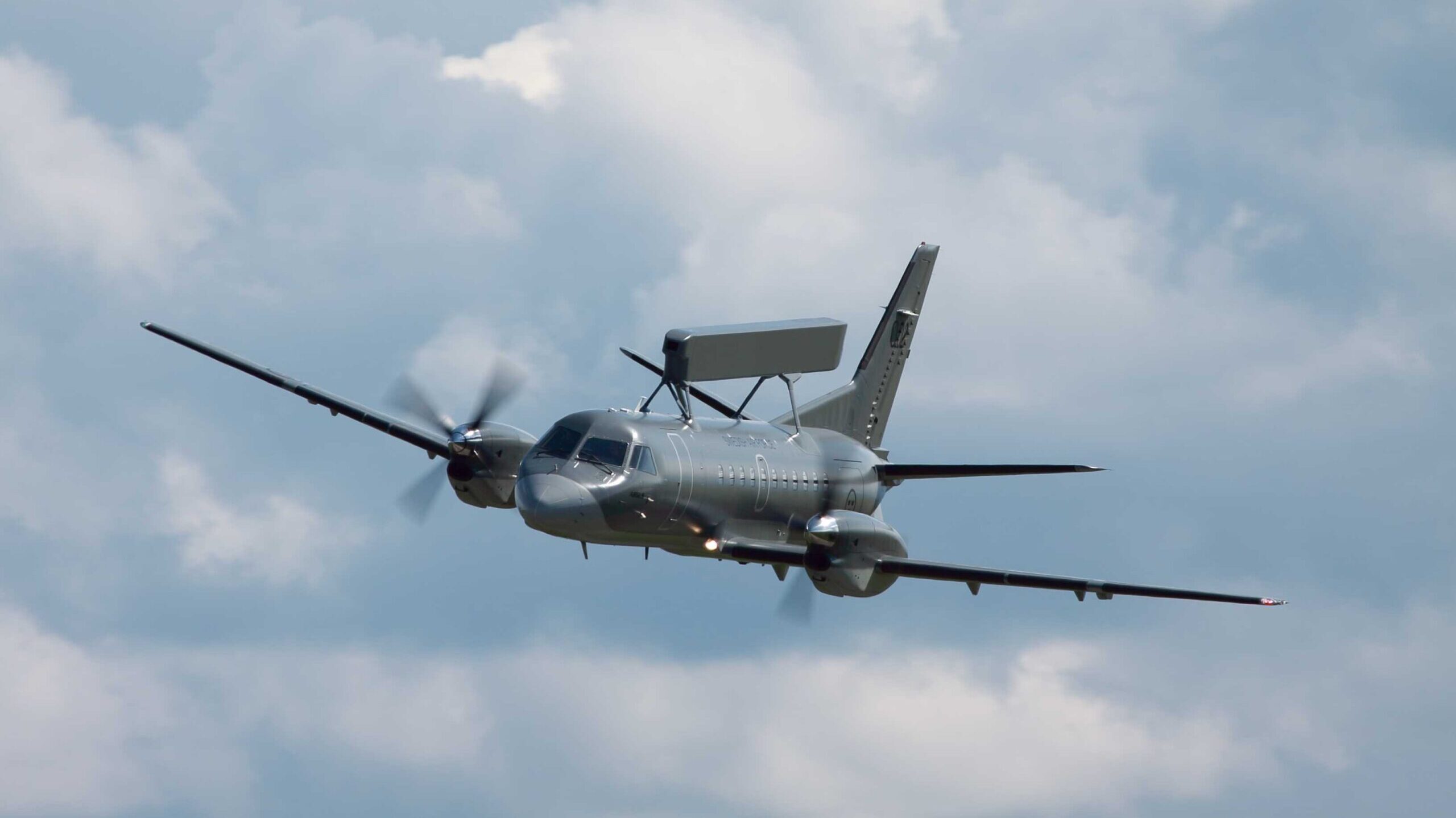
Saab 340 AEW&C in Swedish Air Force service. (Credit: Bartosz Głowacki)
WARSAW — Poland plans to purchase at least two Swedish early warning aircraft to complement additional tethered warning systems, but they’re perhaps not the planes some observers had been expecting.
Early last week Poland’s defense minister, Mariusz Błaszczak, announced that he and his Swedish counterpart, Pal Jonson, had been in discussion, and Warsaw was “very advanced in acquiring early warning aircraft from Sweden.
“We are already conducting detailed negotiations,” he said, “I hope they will be successful in the short term.”
DPM @mblaszczak: I wish to say for the first time publicly that we are advanced in talks to obtain🇸🇪early warning aircraft. We are conducting detailed negotiations. I hope they will succeed in short time. This way we strengthen resilience of🇵🇱, but also of #NATO's eastern flank. pic.twitter.com/9MPIAg9glB
— Poland MOD 🇵🇱 (@Poland_MOD) May 22, 2023
Rumor had it at the time that the deal would be for Swedish manufacturer Saab’s brand new GlobalEye Airborne Early Warning and Control (AEW&C), which is based on a Bombardier Global 6000/6500 long-range business jet and consists of a modern suite of sensors using Saab’s Erieye Extended Range radar and mission system.
But days later, on May 25, the spokesman of the Polish Armament Agency, Lt. Col. Krzysztof Płatek, ended early speculation and announced on social media that his agency “is in talks to acquire 2 Saab 340 AEW&C for the Polish Armed Forces in connection with the offer of the Swedish side, which in the short term will ensure the ability to early detect and warning about air threats.”
The Saab 340 AEW&C is a modified version of a prop plane that dates back 40 years. It’s based on a twin-engine turboprop regional airliner and is equipped with a non-movable PS-890 AESA radar made with the Erieye system, which offers lower drag but has a dead zone directly behind and in front of the plane. The system has a 120-degree zone of scan on either side of the airframe. The PS-890 radar is capable of tracking ships, aircraft and missiles up to 300-400 kilometers while at an altitude of 20,000 feet.
But Lt. Col. Płatek didn’t close the door on the potential for Poland to buy newer aircraft still.
“We do not exclude the purchase of more technologically advanced early warning aircraft in the future”, he added.
As far as when Poland could get the systems, Sweden currently has two surplus 340s that had been purchased by the United Arab Emirates but were returned after the UAE upgraded to GlobalEyes. According to sources here, should Saab wish to sell those to Warsaw, they could be ready later this year or the next. Saab declined to comment for this report.
But should Poland eventually decide to buy GlobalEyes as well, it would presumably take several years for the new planes to come into service.
Tethered Aerostats
Płatek’s announcement about the early warning aircraft came just a day before another announcement regarding early warning systems, this time about tethered aerostats — essentially large blimps carrying their own early warning radar systems.
Płatek tweeted on May 26 that the Polish armament agency submitted an inquiry to the US about four such systems, though he didn’t specify which aerostat programs Warsaw was eyeing.
“Together with early warning aircraft, they will increase the Polish Armed Forces capabilities to monitor the airspace,” Płatek tweeted on May 26,
Agencja Uzbrojenia @Armament_Agency przekazała stronie amerykańskiej zapytanie ofertowe ws. 4 aerostatów rozpoznawczych #BARBARA. Razem z samolotami wczesnego ostrzegania zwiększą one zdolności 🇵🇱Sił Zbrojnych w zakresie monitorowania przestrzeni powietrznej. pic.twitter.com/29AykEckBb
— Krzysztof Płatek (@krzysztof_atek) May 26, 2023
Płatek told the Polish Press Agency that the purpose of acquiring this type of equipment is to “increase the reconnaissance and surveillance capabilities of the Polish Armed Forces to the greatest possible extent, so as to be able to accurately monitor the airspace, what is happening in and around our airspace.”
After deliveries of both AEW&C aircraft and tethered aerostats, Polish Armed Forces will be able to detect low-level flying objects, invisible to ground-based radar stations, such as cruise missiles or combat aircraft, from a long distance.
Currently, Polish airspace is monitored by NATO AWACS aircraft, but Płatek added that Warsaw wants to increase its own operational awareness, such as combat aircraft, which, thanks to the data collected by aerostats and early warning aircraft, will be able to react to the threat earlier.
“Swedish [early warning] aircraft will allow Polish Air Force to develop its own capabilities, which may also allow for support with reconnaissance data from other countries in the region, such as the Baltic States, providing their security, as in the Baltic Air Policing missions. In the same way, we can also acquire data for allies if they ask us to do so,” he said.
Even Higher In The Sky
Płatek also pointed out that the radar data collected by aerostats and AEW&C aircraft will complement other surveillance and reconnaissance systems, much higher.
Early January this year Airbus Defence and Space signed a contract with Poland to provide a geospatial intelligence system including the development, manufacture, launch and delivery in orbit of two high-performance optical Earth observation satellites, which will provide imagery with an accuracy of 30 centimeters. Following the launch of the satellites, which is planned for 2027 from the European Space Centre in French Guiana, the imagery coming in will be directly received in Poland by the infrastructure of the national satellite system.
The contract also covers the associated ground segment, including a Direct Receiving Station in Poland, launch services, training for the Polish team, maintenance and technical support for the space and ground systems. Furthermore, the agreement encompasses the delivery of Very High Resolution (VHR) imagery from the Airbus Pléiades Neo constellation as early as this year.
Air Force awards SNC $13B contract for new ‘Doomsday’ plane
The win is a major victory for the firm in a competition that saw the surprise elimination of aerospace giant Boeing.


























